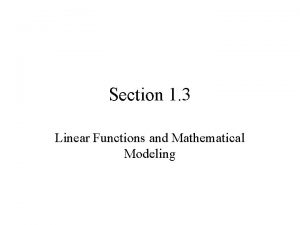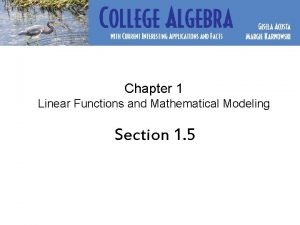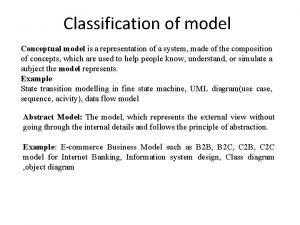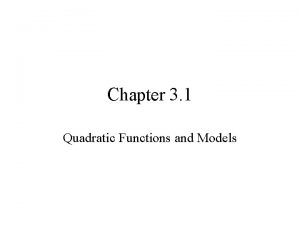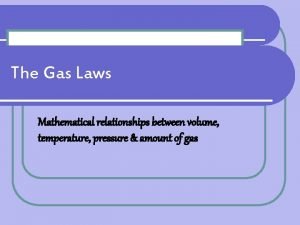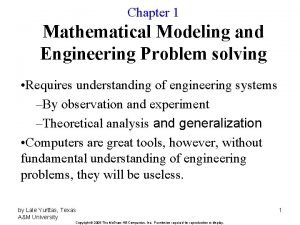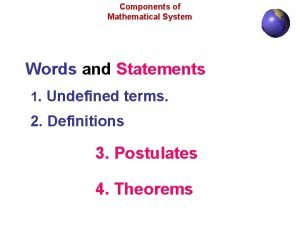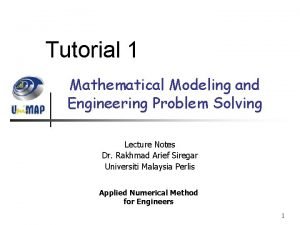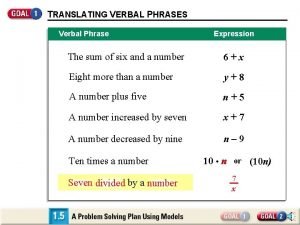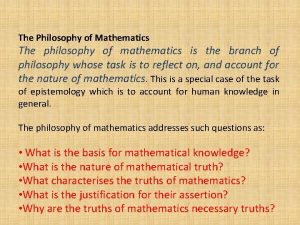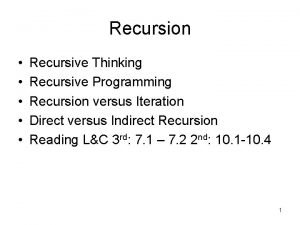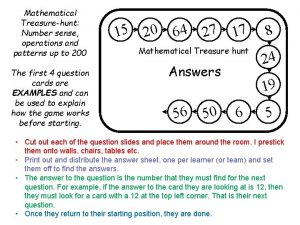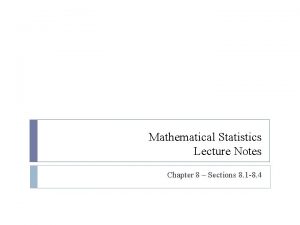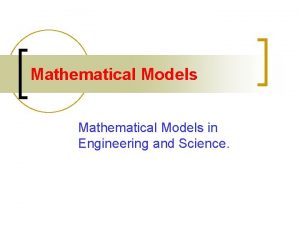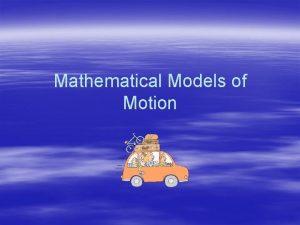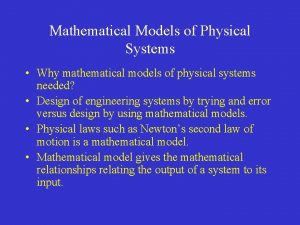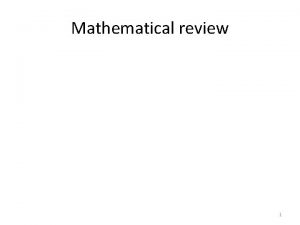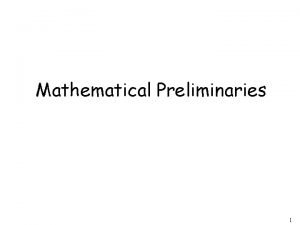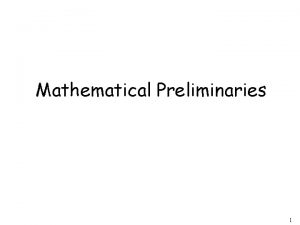Functions and Models 1 1 2 Mathematical Models







































- Slides: 39

Functions and Models 1

1. 2 Mathematical Models: A Catalog of Essential Functions

Mathematical Models: A Catalog of Essential Functions A mathematical model is a mathematical description (often by means of a function or an equation) of a real-world phenomenon such as the size of a population, the demand for a product, the speed of a falling object, the concentration of a product in a chemical reaction, the life expectancy of a person at birth, or the cost of emission reductions. The purpose of the model is to understand the phenomenon and perhaps to make predictions about future behavior. 3

Mathematical Models: A Catalog of Essential Functions Figure 1 illustrates the process of mathematical modeling. Figure 1 The modeling process 4

Linear Models 5

Linear Models When we say that y is a linear function of x, we mean that the graph of the function is a line, so we can use the slope-intercept form of the equation of a line to write a formula for the function as y = f (x) = mx + b where m is the slope of the line and b is the y-intercept. 6

Linear Models If there is no physical law or principle to help us formulate a model, we construct an empirical model, which is based entirely on collected data. We seek a curve that “fits” the data in the sense that it captures the basic trend of the data points. 7

Polynomials 8

Polynomials A function P is called a polynomial if P(x) = anxn + an– 1 xn– 1 +. . . + a 2 x 2 + a 1 x + a 0 where n is a nonnegative integer and the numbers a 0, a 1, a 2, . . . , an are constants called the coefficients of the polynomial. The domain of any polynomial is If the leading coefficient an 0, then the degree of the polynomial is n. For example, the function is a polynomial of degree 6. 9

Polynomials A polynomial of degree 1 is of the form P(x) = mx + b and so it is a linear function. A polynomial of degree 2 is of the form P(x) = ax 2 + bx + c and is called a quadratic function. 10

Polynomials Its graph is always a parabola obtained by shifting the parabola y = ax 2. The parabola opens upward if a > 0 and downward if a < 0. (See Figure 7. ) Figure 7 The graphs of quadratic functions are parabolas. 11

Polynomials A polynomial of degree 3 is of the form P(x) = ax 3 + bx 2 + cx + d a 0 and is called a cubic function. Figure 8 shows the graph of a cubic function in part (a) and graphs of polynomials of degrees 4 and 5 in parts (b) and (c). Figure 8 12

Power Functions 13

Power Functions A function of the form f(x) = xa, where a is a constant, is called a power function. We consider several cases. (i) a = n, where n is a positive integer The graphs of f(x) = xn for n = 1, 2, 3, 4, and 5 are shown in Figure 11. (These are polynomials with only one term. ) We already know the shape of the graphs of y = x. (a line through the origin with slope 1) and y = x 2 (a parabola). 14

Power Functions Figure 11 Graphs of f (x) = xn for n = 1, 2, 3, 4, 5 15

Power Functions Notice from Figure 12, however, that as n increases, the graph of y = xn becomes flatter near 0 and steeper when | x | 1. (If x is small, then x 2 is smaller, x 3 is even smaller, x 4 is smaller still, and so on. ) Figure 12 Families of power functions 16

Power Functions (ii) a = 1/n, where n is a positive integer The function is a root function. For n = 2 it is the square root function whose domain is [0, ) and whose graph is the upper half of the parabola x = y 2. [See Figure 13(a). ] Figure 13(a) Graph of root function 17

Power Functions For other even values of n, the graph of that of is similar to For n = 3 we have the cube root function whose domain is (recall that every real number has a cube root) and whose graph is shown in Figure 13(b). The graph of for n odd (n > 3) is similar to that of Figure 13(b) Graph of root function 18

Power Functions (iii) a = – 1 The graph of the reciprocal function f (x) = x – 1 = 1/x is shown in Figure 14. Its graph has the equation y = 1/x, or xy = 1, and is a hyperbola with the coordinate axes as its asymptotes. Figure 14 The reciprocal function 19

Rational Functions 20

Rational Functions A rational function f is a ratio of two polynomials: where P and Q are polynomials. The domain consists of all values of x such that Q(x) 0. A simple example of a rational function is the function f (x) = 1/x, whose domain is {x | x 0}; this is the reciprocal function graphed in Figure 14 The reciprocal function 21

Rational Functions The function is a rational function with domain {x | x 2}. Its graph is shown in Figure 16 22

Algebraic Functions 23

Algebraic Functions A function f is called an algebraic function if it can be constructed using algebraic operations (such as addition, subtraction, multiplication, division, and taking roots) starting with polynomials. Any rational function is automatically an algebraic function. Here are two more examples: 24

Algebraic Functions The graphs of algebraic functions can assume a variety of shapes. Figure 17 illustrates some of the possibilities. Figure 17 25

Algebraic Functions An example of an algebraic function occurs in theory of relativity. The mass of a particle with velocity v is where m 0 is the rest mass of the particle and c = 3. 0 x 105 km/s is the speed of light in a vacuum. 26

Trigonometric Functions 27

Trigonometric Functions In calculus the convention is that radian measure is always used (except when otherwise indicated). For example, when we use the function f (x) = sin x, it is understood that sin x means the sine of the angle whose radian measure is x. 28

Trigonometric Functions Thus the graphs of the sine and cosine functions are as shown in Figure 18 29

Trigonometric Functions Notice that for both the sine and cosine functions the domain is ( , ) and the range is the closed interval [– 1, 1]. Thus, for all values of x, we have or, in terms of absolute values, | sin x | 1 | cos x | 1 30

Trigonometric Functions Also, the zeros of the sine function occur at the integer multiples of ; that is, sin x = 0 when x = n n an integer An important property of the sine and cosine functions is that they are periodic functions and have period 2. This means that, for all values of x, 31

Trigonometric Functions The tangent function is related to the sine and cosine functions by the equation and its graph is shown in Figure 19. It is undefined whenever cos x = 0, that is, when x = /2, 3 /2, . . Its range is ( y = tan x , ). Figure 19 32

Trigonometric Functions Notice that the tangent function has period : tan (x + ) = tan x for all x The remaining three trigonometric functions (cosecant, and cotangent) are the reciprocals of the sine, cosine, and tangent functions. 33

Exponential Functions 34

Exponential Functions The exponential functions are the functions of the form f (x) = ax, where the base a is a positive constant. The graphs of y = 2 x and y = (0. 5)x are shown in Figure 20. In both cases the domain is ( , ) and the range is (0, ). Figure 20 35

Exponential Functions Exponential functions are useful for modeling many natural phenomena, such as population growth (if a > 1) and radioactive decay (if a < 1). 36

Logarithmic Functions 37

Logarithmic Functions The logarithmic functions f (x) = logax, where the base a is a positive constant, are the inverse functions of the exponential functions. Figure 21 shows the graphs of four logarithmic functions with various bases. In each case the domain is (0, ), the range is ( , ), and the function increases slowly when x > 1. Figure 21 38

Example 5 Classify the following functions as one of the types of functions that we have discussed. (a) f(x) = 5 x (b) g(x) = x 5 (c) (d) u(t) = 1 – t + 5 t 4 39
 Sinusoidal real life examples
Sinusoidal real life examples Linear functions as mathematical models
Linear functions as mathematical models Linear functions as mathematical models
Linear functions as mathematical models Non mathematical economics
Non mathematical economics Conceptual physical and mathematical models are used to
Conceptual physical and mathematical models are used to Mathematical models for impact prediction
Mathematical models for impact prediction Types of mathematical models
Types of mathematical models Math scanner
Math scanner Semi modal verbs
Semi modal verbs Using functions in models and decision making
Using functions in models and decision making What is the domain of a parabola
What is the domain of a parabola Chapter 1 graphs functions and models answers
Chapter 1 graphs functions and models answers How to solve evaluating functions
How to solve evaluating functions Evaluating functions and operations on functions
Evaluating functions and operations on functions Absolute value piecewise function
Absolute value piecewise function Black gold ict div 2
Black gold ict div 2 Maps and plans maths lit
Maps and plans maths lit Maps and plans maths lit
Maps and plans maths lit Maths literacy grade 12 finance questions and answers
Maths literacy grade 12 finance questions and answers Mathematical foundations of computer graphics and vision
Mathematical foundations of computer graphics and vision Mathematical modeling and engineering problem solving
Mathematical modeling and engineering problem solving Types of maps maths lit
Types of maps maths lit Difference between mathematics and mathematical literacy
Difference between mathematics and mathematical literacy Introduction and mathematical concepts
Introduction and mathematical concepts Physics chapter 1 introduction and mathematical concepts
Physics chapter 1 introduction and mathematical concepts Measurement maths literacy grade 12
Measurement maths literacy grade 12 What is definition
What is definition Mathematical modeling and engineering problem solving
Mathematical modeling and engineering problem solving Mathematical literacy grade 11 maps and plans
Mathematical literacy grade 11 maps and plans Blackboard equation editor
Blackboard equation editor Verbal phrases to mathematical phrases examples
Verbal phrases to mathematical phrases examples Absolutist view of mathematics
Absolutist view of mathematics Most important kinds of mathematical statements
Most important kinds of mathematical statements Mathematical equation of gay lussac's law
Mathematical equation of gay lussac's law Recursion vs loop
Recursion vs loop Flourishkh.com
Flourishkh.com Proposes rules for intelligence
Proposes rules for intelligence Mathematical symbols with name
Mathematical symbols with name How to make mathematical treasure hunt
How to make mathematical treasure hunt Mathematical statistics notes
Mathematical statistics notes

